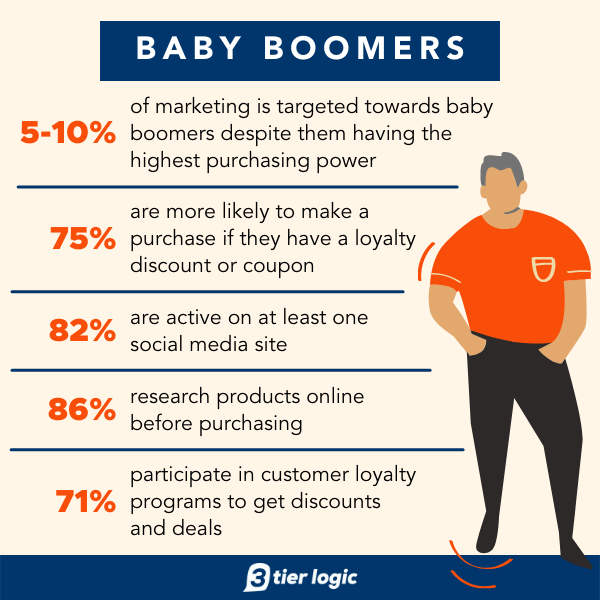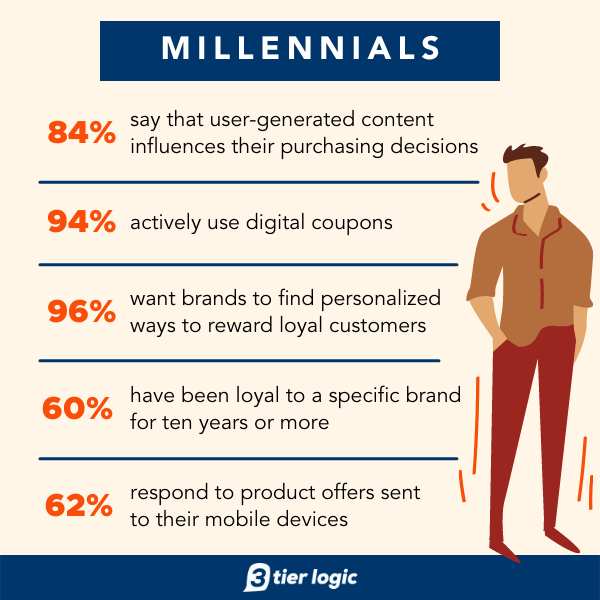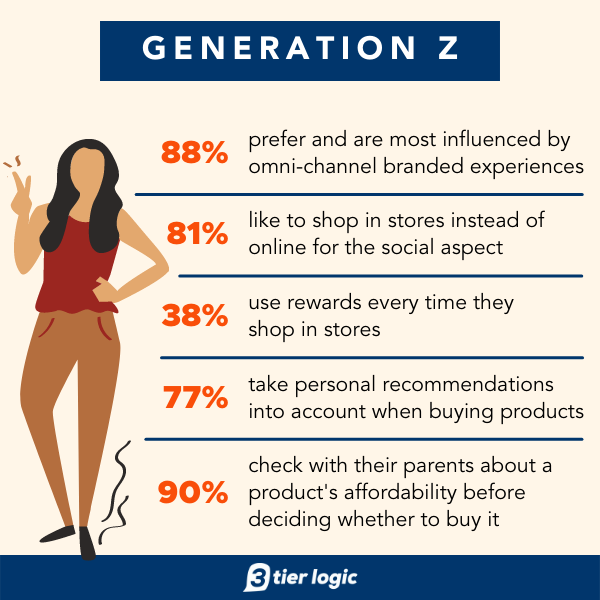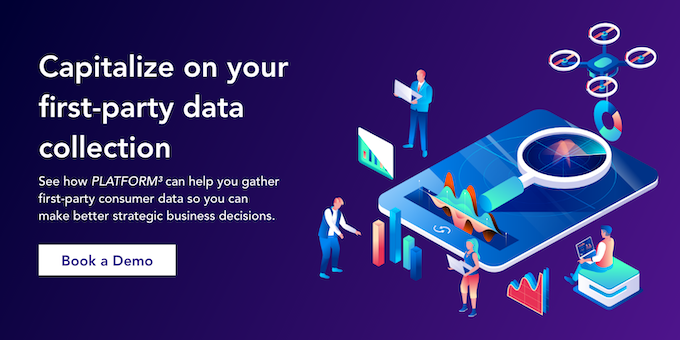What is Generational Marketing? (Examples Included)
When it comes to connecting with customers, one of the biggest challenges companies face is understanding who they are and how that defines the way they shop. There are an endless number of ways to segment them, whether by age or gender, geographic location or cultural background, or what types of marketing campaigns catch their eye. However, what if you were to build a generational marketing strategy instead?
Unsurprisingly, different generations think and behave differently. For example, which generations are more likely to sign up for a loyalty program? Which generations are less likely to shop in stores? Their mindsets are often influenced or even defined by which generation they belong to. Rather than focusing on one single data point, generational segmentation provides marketers with a well-rounded customer profile that acts as a starting point for identifying their values, motivations, and purchasing behavior. How can companies use generational marketing to build a marketing strategy framework?
What is generational marketing?
In generational marketing, customers are segmented and targeted by generation, determined by the year they were born. Currently, we have four main generations: baby boomers, generation X (Gen X), generation Y (millennials), and generation Z (Gen Z). Each generation has its own set of beliefs, preferences, and shared experiences, which influence the way they think and act. Cultural and sociopolitical factors, such as technological developments and financial instability, are some of their biggest drivers.
Their mindsets not only define who they are as people, but who they are as consumers. For example, 57% of Generation X say they’re still recovering from the Great Recession today, and therefore are more likely to save for retirement due to financial anxiety than spend their disposable income. 75% of millennials and Gen Zers, who grew up with modern technology, use smartphones to shop online. Some might respond well to new innovations, while others prefer that their products and services stay exactly the same.
Generational marketing shouldn’t be a company’s only consideration as to how to segment their customers. Other factors like location, income, and individual interests usually come into play. However, it does provide a strong foundation for designing and analyzing personalized marketing campaigns that helps to create fully-developed strategies for the future.
Generation-by-Generation Breakdown
Baby Boomers
Characteristics
Baby boomers were born in the mid-1940s to the early 1960s. As a post-war generation, baby boomers grew up in a time of prosperity and economic growth. Of all the generations, they hold the most purchasing power and have the most discretionary income. They’ve spent most of their lives without modern technology, but many have embraced mobile devices, social media, and online shopping.
Today, most baby boomers are empty nesters that are either retired or close to retirement. They no longer need to save money to pay for their education, mortgage, or family. While some spend freely on luxury goods, others are more frugal due to recent economic instability. Baby boomers are highly motivated by good deals and are very brand loyal.
(Sources: HubSpot, Synchrony, Salesforce)
Strategies
People often assume that baby boomers are best reached through traditional marketing methods like print ads or television commercials. However, many of them have smartphones, tablets, and Facebook accounts. The best way to appeal to them is through coupons, special offers, and email marketing campaigns.
Brands like Kellogg’s® have successfully marketed their products to discount-driven baby boomers through gift with purchase programs, such as their Cash for Gas promotion. When consumers purchased two qualifying cereal products in one transaction, they became eligible for a $5 gas prepaid card. Shoppers could participate up to five times, encouraging consumers to make repeat purchases to gain even more savings.
Grammarly, on the other hand, informed baby boomers about their special offer through email campaigns. For a limited time, they offered consumers a 46% discount on their annual premium plan to help them improve their writing. The email’s simple layout, large text, and contrasting colors made it easy to digest and understand exactly what was being offered and where to get it.
Generation X
Characteristics
Generation X, or Gen X, was born in the mid-1960s to the early 1980s. Gen Xers are often overlooked, being both the smallest generation and the bridge between baby boomers and millennials. Unlike their parents, they grew up in a recession, meaning they've been cautious with money their entire lives. They're also more skeptical, meaning they trust companies and their marketing efforts less than other generations.
Today, Gen Xers are hesitant about change and new innovations, preferring to stick to what they know, which makes them the most brand-loyal generation. They also respond well to companies that leverage nostalgia, such as marketing campaigns that feature celebrities or music that they associate with their childhood.
(Sources: eMarketer, Business2Community, RevLocal)
Strategies
As the most brand-loyal generation, Gen Xers respond best to customer loyalty programs. When their favorite brands offer discounts and reward points, they’re more likely to make additional purchases so they can save money in the long run. They’re also more active on social media platforms like Facebook than baby boomers, meaning Facebook ads and pages - especially those with customer reviews - are some of the best ways to keep them up-to-date on new products and deals.
Promotions like Toro’s The One Landscape Contractor Loyalty Program help reinforce Gen Xers’ loyalty. When landscape contractors purchase qualifying Toro products, they can earn points and redeem rewards via Toro’s consumer portal. They can also earn points by watching informational videos or talking about the program on Facebook.
Amazon kept Gen Xers up-to-date on their Black Friday deals through Facebook ads. The sample product and its rating especially helped to capture consumers’ interest, as Gen Xers typically trust customer reviews and their honest opinions more than company marketing campaigns.
Millennials
Characteristics
Generation Y, also known as millennials, was born in the mid-1980s to the mid-1990s. They were the first generation to grow up with modern technology. Millennials are not only the largest demographic in the workforce but the largest generation in history. This presents an opportunity for brands to market to a wider audience and build a large customer base. They are more likely to spend than save and prefer value over convenience.
Today, millennials are typically the most talked-about generation across every industry. They place more importance on authentic brand messaging than previous generations, seeking out brands that are socially and environmentally conscious. They also prefer user-generated content over marketing campaigns. 82% of millennials value word-of-mouth advertising from family, friends, and influencers above all else because they value peer acceptance and social advocacy. Lastly, when it comes to consumer packaged goods, they prefer brands that have consistently low prices over those that constantly offer deals.
(Sources: Bazaarvoice, Lexington Law, HubSpot, Synchrony)
Strategies
Millennials have gone from being the most brand loyal to one of the least brand loyal generations in recent years. They have a higher tendency to switch brands depending on changes in price and customer service, and care less about selection and convenience. The best way to keep them engaged with your brand is through SMS marketing, social media, and user-generated content. They’re also more likely to remain loyal to brands that donate to charitable causes and offer memorable experiences they can share with their social media following and loved ones.
One example of an experience-based promotion that especially appealed to millennials was Six Pints Beer Co.’s Creemore Experience sweepstakes. Rather than providing discounts or rewards, they offered consumers the chance to win a weekend getaway in Creemore or a multi-course dinner in Toronto when they purchased specially-marked cases of Creemore Lager.
Aerie’s ongoing #AerieREAL UGC campaign, focused on body positivity, has been especially successful with millennials. The clothing brand encouraged consumers to post unedited photos of themselves on Instagram wearing Aerie products. Aerie promised to donate $1 to the National Eating Disorders Association for every unedited photo that had the #AerieREAL hashtag. This promotion not only helps millennials become part of a brand’s community, but gives them an opportunity to donate to a good cause, too.
Generation Z
Characteristics
Generation Z, or Gen Z, was born in the mid-1990s to the early to mid-2010s. Currently, Gen Z is both the most diverse and the most tech-savvy generation. While many of them are still young, they already hold a significant amount of global spending power. Due to economic uncertainty stemming from the Great Recession and the COVID-19 pandemic, they value financial stability above all else and are responsible spenders.
Today, Gen Z relies more on reviews, recommendations, and social media than any other generation. They engage best with brands that utilize social selling techniques and those that actively respond to their comments and feedback. While they do experience significant stress about personal debt and look for ways to save money, they’re less likely to sign up for loyalty programs compared to Gen X.
(Sources: HubSpot, Lexington Law, JWT Intelligence)
Strategies
Despite being money-conscious, Gen Zers care less about finding deals and more about finding brands who share their beliefs. Even more so than millennials, they’re more likely to show loyalty to companies that are environmentally and socially responsible than those that don’t engage in ethical issues at all. They also want brands to engage with them as individuals and offer personalized products and experiences that help them express themselves.
Promotions like Rachael Ray Nutrish’s Furever Home give Gen Zers the opportunity to purchase products and contribute to a cause they believe in at the same time. When consumers bought qualifying products, they received one entry into a sweepstakes contest for the chance to win $25,000. They were encouraged to make multiple purchases for more entries, which were put towards Nutrish’s $250,000 donation to animal shelters.
Spotify, a music streaming service, is best known for its “Discover Weekly” playlists of personalized recommendations, allowing Gen Z to find new music that’s similar to what they already listen to. They also recently launched its “Only You” campaign, which gave consumers a personalized summary of their listening habits. These unique cards were designed to be easily shared on social media.
Additional Considerations for Generational Marketing
Pros and Cons
Generational marketing provides a strong framework for companies to build on. Unlike segmenting by demographics like gender or location, generational segmentation creates a more complete picture of target markets on their path to purchase. It helps companies determine where to find them, how to communicate with them, and how to turn them into loyal customers. For example, if a product is primarily designed for younger generations, marketers can connect with them through social sharing. If a brand caters mostly to older generations, it can nurture customers through loyalty programs.
However, generational marketing may not be suitable or relevant to all businesses. For example, if a company’s products are for women of all ages or for people who play an instrument, then generational marketing may be more of a suggested guideline than a set of rules. Additionally, those who make assumptions about their customers solely based on what generation they belong to might end up designing ineffective marketing campaigns.
Generational marketing fallacies
One of the biggest mistakes companies and marketers often make is taking generational stereotypes at face value. For example, while you could assume that older generations prefer to save instead of spend, or that most young people can be found on social media, they’re still broad, sweeping generalizations.
Generational marketing is more of a starting point than a complete strategy. It helps companies get an overall sense of their customers’ perspectives, such as how they prefer to find product information or how they like to engage with brands. At the end of the day, marketers should combine demographic-based information with first-party data to build and adjust their buyer personas. From there, they can design personalized marketing campaigns that meet their customers where they are.
How to leverage generation-based data
How can companies combine generational marketing concepts with first-party data to develop a better understanding of their customers? As previously mentioned, a basic understanding of the different generations can be a strong foundation for further analysis. By designing programs and running promotions like the ones outlined above, marketers can get a better idea of what their consumers’ path to purchase looks like.
For example, while statistics show that younger generations tend to be less interested in loyalty programs, this may not necessarily apply to your product or services. First-party data can highlight precisely the types of consumers that are engaging and shopping with your brand. Therefore, companies may want to tweak their messaging to capture audiences that are actually interested in their brand. This might mean using strategies that work best on younger crowds - social sharing and experiences - or pivoting to interest older people with coupons and discounts instead.
While generational marketing isn’t for everyone, it can be beneficial for developing buyer personas and planning marketing strategies. With 3 tier logic’s PLATFORM³, brands can host and launch loyalty programs, gift with purchase promotions, sweepstakes, contests, and more. The Data Capture & Analytics dashboard can also help you make informed business decisions about how to better connect with your customers. To learn more, book a demo with our team today.













